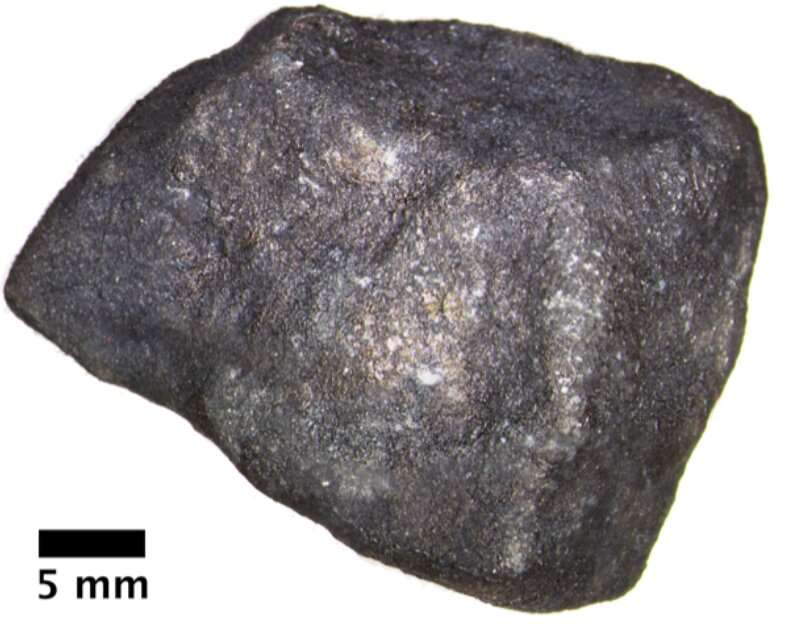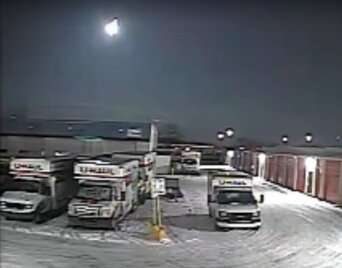'Fireball' meteorite contains pristine extraterrestrial organic compounds

On the night of January 16, 2018, a fireball meteor streaked across the sky over the Midwest and Ontario before landing on a frozen lake in Michigan. Scientists used weather radar to find where the pieces landed and meteorite hunters were able to collect the meteorite quickly, before its chemical makeup got changed by exposure to liquid water. And, as a new paper in Meteoritics & Planetary Science shows, that gave scientists a glimpse of what space rocks are like when they're still in outer space—including a look at pristine organic compounds that could tell us about the origins of life.
"This meteorite is special because it fell onto a frozen lake and was recovered quickly. It was very pristine. We could see the minerals weren't much altered and later found that it contained a rich inventory of extraterrestrial organic compounds," says Philipp Heck, a curator at the Field Museum, associate professor at the University of Chicago, and lead author of the new paper. "These kinds of organic compounds were likely delivered to the early Earth by meteorites and might have contributed to the ingredients of life."
Meteorites, simply put, are space rocks that have fallen to Earth. When things like asteroids collide in outer space, fragments can break off. These pieces of rock, called meteoroids, continue floating through space, and sometimes, their new paths collide with moons or planets. When a meteoroid breaks through the Earth's atmosphere and we can see it as a fireball or shooting star, it's called a meteor. If pieces of that meteor survive the trip through the atmosphere, the bits that actually land on Earth are called meteorites.
When the fireball arrived in Michigan, scientists used NASA's weather radar to track where the pieces went. "Weather radar is meant to detect hail and rain," explains Heck. "These pieces of meteorite fell into that size range, and so weather radar helped show the position and velocity of the meteorite. That meant that we were able to find it very quickly."

Less than two days after it landed, meteorite hunter Robert Ward found the first piece of the meteorite on the frozen surface of Strawberry Lake, near Hamburg, Michigan. Ward worked with Terry Boudreaux to donate the meteorite to the Field Museum, where Heck and Jennika Greer, a graduate student at the Field and the University of Chicago and one of the paper's authors, began to study it.
"When the meteorite arrived at the Field, I spent the entire weekend analyzing it, because I was so excited to find out what kind of meteorite it was and what was in it," says Greer. "With every meteorite that falls, there's a chance that there's something completely new and totally unexpected."
The researchers quickly determined that the meteorite was an H4 chondrite—only 4% of all meteorites falling to Earth these days are of this type. But the real thing that makes the Hamburg meteorite exceptional is because of how quickly it was collected and how well-analyzed it is.
"This meteorite shows a high diversity of organics, in that if somebody was interested in studying organics, this is not normally the type of meteorite that they would ask to look at," says Greer. "But because there was so much excitement surrounding it, everybody wanted to apply their own technique to it, so we have an unusually comprehensive set of data for a single meteorite."

Scientists aren't sure how the organic (carbon-containing) compounds responsible for life on Earth got here; one theory is that they hitched their way here on meteorites. That doesn't mean that the meteorites themselves contain extraterrestrial life; rather, some of the organic compounds that help make up life might have first formed in an asteroid that later fell to Earth. (In short, sorry, we didn't find any aliens.)
"Scientists who study meteorites and space sometimes get asked, do you ever see signs of life? And I always answer, yes, every meteorite is full of life, but terrestrial, Earth life," says Heck. "As soon as the thing lands, it gets covered with microbes and life from Earth. We have meteorites with lichens growing on them. So the fact that this meteorite was collected so quickly after it fell, and that it landed on ice rather than in the dirt, helped keep it cleaner."
The buzz around the meteorite when it landed also helped scientists learn much more about it than many other meteorites of its kind—they used a wide variety of analytical techniques and studied samples from different parts of the meteorite to get a more complete picture of the minerals it contains. "You learn a lot more about a meteorite when you sample different pieces. It's like if you had a supreme pizza, if you only looked at one little section, you might think it was just pepperoni, but there might be mushrooms or peppers somewhere else," says Greer.
"This study is a demonstration of how we can work with specialists around the world to get most out of the small piece of raw, precious piece of rock," says Heck. "When a new meteorite falls onto a frozen lake, maybe even sometime this winter, we'll be ready. And that next fall might be something we have never seen before."
Provided by Field Museum



















